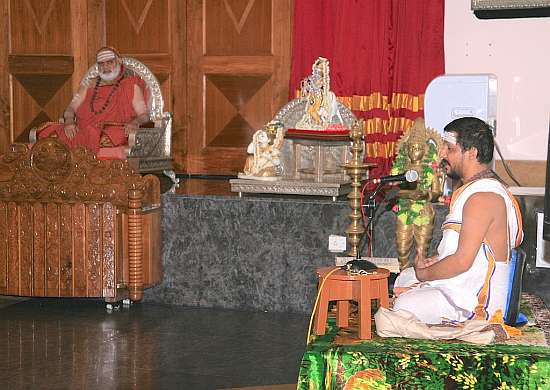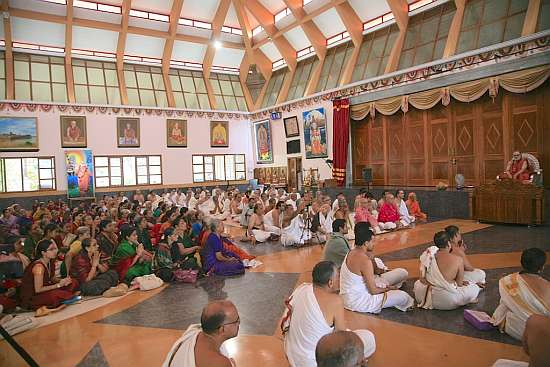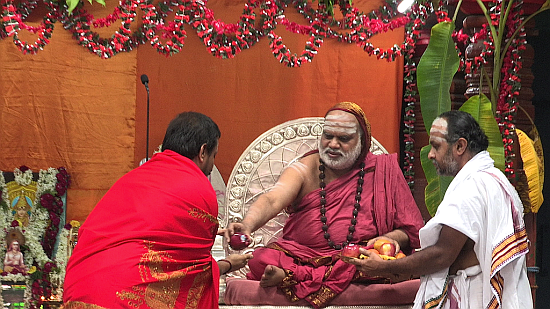Bhagavata Saptaha at Sringeri

Nochur Venkataraman during the Bhagavata Saptaha in Guru Nivas in the Jagadguru’s presence
With the blessings of Jagadguru Shankaracharya Sri Sri Bharati Tirtha Mahaswamiji, a Bhagavata Saptaham was organized in Sringeri by a group of devotees led by Sri Natarajan of Arasikere. Renowned Upanyaska and Sadhaka, Sri Nochur Venkataraman conducted the Bhagavata Saptaha in Pravachana Mandiram near Goddess Sharadamba temple from 14th June to 21st June. The Saptaham began on 14th June 2013 with the Jagadguru personally blessing the start of the event. The event commenced with the Parayana of the Bhagavata Mahatmyam followed by a discourse on the significance and greatness of Bhagavatam by Sri Nochur Venkataraman. Hundreds of devotees attended the event.
From 15th June onwards, Parayanam of Srimad Bhagavatam began everyday at 5:30 am and went on till 3:30 pm in the afternoon. Sri Nochur Venkataraman delivered lectures in Tamil in the mornings from 7:30 am to 9 am and from 3:30 pm to 5 pm. The lectures were tinged with Bhakti and Jnana as Sri Venkataraman described various events in the Bhagavatam such as the Kapila Upakhyanam, the Uddhava Gita, the Jada Bharata Upakhyanam, the Prahlada Charitam and so on.
On 19th June 2013, at the request of the devotees, the afternoon lecture of Sri Nochur Venkataraman covering the Dashama Skanda of Bhagavatam took place in the divine presence of the Jagadguru at Guru Nivas in Narasimha Vanam.

Audience listening to Nochur Venkataraman during the Bhagavata Saptaha in Guru Nivas in the Jagadguru’s presence
On the concluding day In His Anugraha Bhashanam rendered in Tamil at the Pravachana Mandiram, the Jagadguru said that Srimad Bhagavatam’s importance is underlined by the fact that Bhagavan Veda Vyasa found satisfaction only after composing this Mahapurana that extols the Supreme Being. The ever-fresh and attractive Lilas of Bhagavan Sri Krishna, described in the 10th Skanda of Srimad Bhagavatam bring divine joy to the reader and the listener. Inspired by the account of the life of Bhagavan in Srimad Bhagavatam, many great people penned literature in the form of Kavyas, Natakas, Stotras in many languages and fulfilled the purpose of their lives. One has to only look at the Krishna Karnamrtam of Lila Shuka or the Gita Govinda of Jayadeva to get a taste of the devotion and emotion expressed in such literature.
The Jagadguru then talked about the greatness of Bhagavan Sri Krishna. Referring to a statement of Bhagavan in the Gita – यन्मे त्वदन्येन न दृष्टपूर्वम् – where Bhagavan tells Arjuna that he is the first to see the Vishwaroopam or the Cosmic form, the Jagadguru said that some wonder if this statement is indeed true. This question arises because Bhagavan had shown a similar form to Mother Devaki at the time of His birth, and also to Mother Yashoda, when she demanded that He open His mouth to check if He had indeed swallowed mud. The Jagadguru pointed out that it is not uncommon in the world that in order to give joy to the recipient, the giver says, “What I am giving you now has never been given to anyone else before”. Similarly, we also say, “What I am saying has never been told to anyone else”. This too gives a sense of importance to the hearer. Could Bhagavan also be doing the same when He says to Arjuna that He has never shown the Vishwaroopam to anyone else before?.
However, Bhagavan cannot lie. The Jagadguru in His own inimitable way explained that Bhagavan had used the word “anyena” (by others) in the masculine gender to imply that no man before Arjuna had seen the Vishwaroopam. Hence no one need have the doubt in the statement of Bhagavan for Devaki and Yashoda who had also seen the Vishwaroopam earlier were women. The Jagadguru explained that He had provided this illustration to indicate that the words of Bhagavan can never be categorized under falsehood. The intelligence and the adherence to Dharma that Bhagavan exhibited during His presence on earth is impeccable. Some question the relation between Bhagavan and the Gopikas and wonder if it conforms with Dharma. Sri Shuka Maharshi Himself says in the Bhagavatam – तेजीयसां न दोषाय वह्नेः सर्वभुजो यथा – that Bhagavan remains unaffected, even as fire that burns everything, cannot itself be burnt or be affected. The Dharma Shastras also say – दृष्टो धर्मव्यतिक्रमः साहसं च महताम् – Great personages appear to transgress Dharma (sometimes). However they remain unaffected. This does not mean that we too can take to this course of action. Anything that is dropped in the sacrificial fire is burnt and reduced to ashes. However, we cannot consume all of them and assume that the digestive fire in our stomachs can burn everything. Similarly, we cannot imitate every act of Bhagavan. Rather we must foster devotion and faith towards Him. Bhagavan Himself declares this and says in His own words that such a person who surrenders everything and acts for Him, is freed from all bondages of Karma and attains Him –
मन्मना भव मद्भक्तो मद्याजी मां नमस्कुरु ।
मामेवैष्यसि युक्त्वैवमात्मानं मत्परायणः ॥यत्करोषि यदश्नासि यज्जुहोषि ददासि यत् ।
यत्तपस्यसि कौन्तेय तत्कुरुष्व मदर्पणम् ॥
शुभाशुभफलैरेवं मोक्ष्यसे कर्मबन्धनैः ।
That is why we end even our Pujas with the statement – तत् सत् ब्रह्मार्पणमस्तु – that conveys that the Puja itself has been done as an offering to Him.
The uniquess of the Avatara of Bhagavan Sri Krishna is that it is here that the Gita Upadesha has been given. Even if people cannot study Srimad Bhagavatam, one may study Sriman Narayaneeyam that is a concise form of the Mahapurana and was penned by Sri Narayana Bhattatiri.
The Jagadguru then praised Sri Nochur Venkataraman for conducting the Bhagavata Saptaham in a befitting manner, and blessed one and all.

Jagadguru blessing Nochur Venkataraman
The event ended with Sri Nochur Venkataraman receiving the Jagadguru’s Blessings and the Avabhrita Snanam of the Vigraha of Bhagavan Sri Krishna taking place in the sacred waters of the holy Tunga river.
